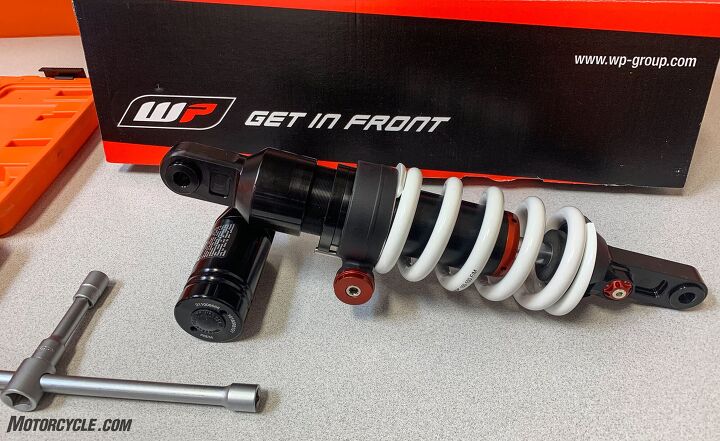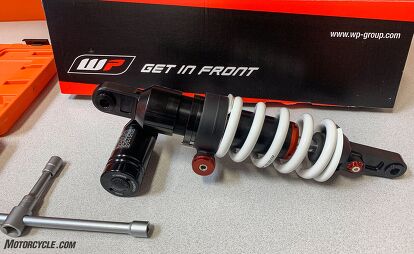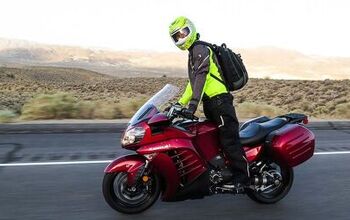MO Tested: WP Apex Pro 6500 Cartridges And 6746 Shock For KTM 790 Duke

Adding the suspension adjustability that KTM left out of the 790 Duke
News flash: OEM suspensions are designed to a price point. So, unless you’re riding a flagship literbike, those suspenders are full of compromises. The stock suspension on the vast majority of bikes out there is designed for an average rider, going an average pace, over an average road. Get outside of those parameters, and the suspension’s performance is compromised.
Perhaps the biggest complaint leveled against the 2019 KTM 790 Duke is it coming equipped with bargain suspenders. The 43 mm WP inverted fork is devoid of any adjusters, and the WP shock only has ramped preload. The good news for such a simple suspension is that it works pretty dang well. So well, in fact, that many riders will find the stock stuff does most of what they’d want it to do. While the versatility of the 790 Duke is admirable (around town and out on the freeway, the suspension is quite nice), I began to find myself stepping outside of its ideal range of operation with increasing regularity. Some of it is most certainly due to my 200 lb weight – without gear – and the rest is because the Duke has gotten me back into doing track days on a regular basis.
With the writing on the wall, I began to look to the aftermarket for some upgrades, and I settled on WP’s Apex Pro line based largely on the fact that Chris Fillmore helped develop the components on the way to his Pikes Peak win and middleweight record on the 790 Duke. My choice is not meant to imply that my riding skills are even in the same area code as Fillmore’s (because they’re not) but rather the acknowledgment that Pikes Peak is notoriously bumpy and the mountain roads and tracks that I haunt have their own share of bumps, too.
WP’s Apex Pro line of suspension components has been around for a while, and the selection of parts ranges from cartridge replacements to full fork assemblies and shocks for many different sportbikes. There is even an Apex Pro steering damper. Introduced in February 2019, the most recent additions to the Apex Pro line of street-focused suspension components, the Apex Pro 6500 Cartridges and 6746 Shock, were initially made available for the 790 Duke and the Yamaha MT-09, with models for BMW, Kawasaki, Husqvarna, and others planned for future release.
WP Apex Pro 6500 Cartridges
The Apex Pro 6500 cartridges are designed to be drop-in replacements for the 790 Duke’s OEM WP units. As with the stock cartridges, the compression damping is handled by the left fork leg, and the rebound is managed by the right, giving complete separation of the two circuits. Unlike the OEM units, the 6500s also include preload adjustment.
The cartridges themselves are manufactured out of anodized aluminum to much tighter tolerances than the stockers. Three different spring rates are available to account for rider weight. The springs are straight rate and not progressive like the OEM items. The fork cap allows for adjustable preload to help fine-tune the bike’s sag within the range of weights supported by the springs. Installation is as simple as removing the original cartridges, inserting the Apex ones and adding the right amount of fork oil. Although an experienced home mechanic could handle the swap, WP requires that you purchase Apex Pro components from one of its certified suspension centers. So, I decided to have WP techs take care of the installation, too.
Three spring rates are offered for the 6500 cartridges. Standard covers rider weights from 165-187 lb. with a 6.5 N/mm (37.1 lb/in), while lighter and heavier riders can order 6.0 N/mm (34 lb/in) and 7.0 N/mm (40 lb/in), respectively. Preload adjustment requires a wrench. Changes to the fork’s compression and rebound damping are handled by turning the winged screws atop the fork legs and can be done without tools. For baseline damping settings, WP gives three ranges of clicks out from fully closed. Comfort is 20 clicks, Standard is 15 clicks, and Sport is 10 clicks, with the lower number of clicks giving the least compliant ride.
WP Apex Pro 6746 Shock
Unlike the budget-priced OEM WP shock, which is made of steel, the Apex Pro 6746 Shock is constructed from CNC-machined and anodized aluminum for strength and lightness. Since the 790 Duke’s shock is so tightly packed inside the frame, I opted for the version of the 6746 with the “racing-type” preload adjuster. Instead of fighting to turn the shock collar in the tight space of the frame, a 6 mm Allen key makes the task super simple. It was well worth the extra $100 and the smidge of extra weight. As with the cartridges, the shock has a standard spring rate ( 150 N/mm (857 lb/in)), a lighter (140 N/mm (799 kb/in)), and a heavier (160 N/mm (914 lb/in)) option.
Aside from preload, the 6746 has adjustments for high- and low-speed compression damping and rebound. Adjusting the shock’s damping requires two different tools, a 4 mm Allen key and a flathead screwdriver. (I found a handy little stubby screwdriver on Amazon that had both, and I keep it wrapped in a shop rag in the tail section.) Like with the fork, the WP shock has three baseline settings: Sport – 9 clicks out, Standard – 12 clicks, and Comfort – 16 clicks. These became my starting points for suspension setup.
On the street and to the track
Because I’m that kind of guy, I initially adjusted the fork and shock to the Sport settings and quickly learned that they were too stiff for everyday riding. In fact, my first ride with the upgraded suspension was an hour-long freeway jaunt to pick up some camera gear. For my trip home, I went to the other extreme, set the suspenders on Comfort, and rode a magic carpet home. Lesson learned. Now, when I’m running errands on the interstate, I take the two minutes necessary to make the adjustments so that I glide over the expansion joints.
For my first canyon run, the adjusters went back to Sport, and when the pavement was smooth, I was in sport riding heaven. Dive under braking was dramatically reduced, and the bike felt much more planted mid-corner. The hobby-horse effect of compression bumps when cornering was gone. However, I ride in the real world, and some of the roads I regularly traverse are quite bumpy. So, back to the adjusters I went. In the end, I found the right compromise for the type of riding I do to be a click or two between Standard and Sport. Unless I’m taking an extended freeway trip, I keep the settings here for most of my riding.
My first trip to the track with the WP Apex Pro components in place was at Willow Springs’ Big Track, and the 10 years since my last trip there had not been kind to it. For such a fast track, it has some extremely bumpy sections that were quite jarring at the speeds at which they were encountered. Ironically, despite the higher speeds, I ended up with slightly softer suspension settings than I did for the street. (Specifically, a click under the standard setting.) Still, the wallow that the Duke exhibited at high speeds on the track with the stock suspension was gone. Overall, the chassis remained more stable in every situation, despite the bumpiness.
The second track day was at Chuckwalla Valley Raceway, and again, having the ability to adjust my suspension made it possible to tune the suspension to the track conditions. Chuckwalla’s surface is significantly smoother, allowing me to run stiffer settings. For this day, the 790 felt like it was on rails throughout the 170 miles I logged. Although WP is promoting the Apex Pro as a street-focused suspension, the range of adjustments available makes it extremely useful on the track, too.
With great power comes great responsibility
Hopefully by now, you’ve realized that the WP Apex Pro suspension consists of finely-tuned components. With that precision and adjustability comes the recommendation of some additional maintenance. After the first 3,100 miles (5,000 km), the optional-but-recommended initial service should be done front and rear. Think of it like you would the shortened first service interval for the engine. Even with the finely calibrated tolerances of manufacturing, there will be some wearing-in of the metal components. So, an oil change is in order. After that, the service interval is every 12,400 miles (20,000 km).
This point in the article is where I planned on comparing the maintenance schedule of the OEM suspension to the WP parts, but KTM doesn’t list one in its factory service manual. Instead, it says that every year or 15,000 miles one should: “Check the shock absorber and fork for leaks. Perform fork service as needed and depending on how the vehicle is used.” After poking around in several of the factory service manuals that I have in my garage, I discovered that KTM is not alone in this odd maintenance omission for street bikes. Typically, I would expect fork oil maintenance interval to be roughly every 10,000-15,000 miles. So, after the initial service, the maintenance schedule is roughly the same as OEM components. The difference is that most riders ignore the service of their stock suspension. Those who invest in WP Apex Pro components to improve their bike’s handling should maintain them to keep them operating according to specifications.
In summary
As I said at the beginning of the article, the stock WP suspenders were fine for a good bit of the street riding that I did on the Duke. However, on the street when the pace got above a certain level of aggression – and certainly at track days – the forces directed at the suspension moved beyond its comfort zone. These two areas are where the Apex Pro components shine thanks to their more precise construction. Priced at $879 for the 6500 Cartridges and $1,099 for the 6746 Shock ($999 without the convenient preload adjuster), the components aren’t cheap. What you get for that money, though, is a bike that handles better in every sport riding condition, thanks to the suspension’s tunability. Even with that increased sportiness, you don’t have to give up comfort – though it is a little firmer than stock – when the riding situation calls for it. If you’re a performance-minded KTM 790 Duke owner who is bumping up against the limitations of the OEM suspenders, this is the upgrade you have been looking for. Since the Yamaha MT-09’s suspension is, in my experience (and particularly with the early models),less competent than the Duke’s, I would expect the WP Apex Pro suspension to make a big improvement on the MT, too. To find the WP-certified suspension center nearest you, visit the WP web site.

Like most of the best happenings in his life, Evans stumbled into his motojournalism career. While on his way to a planned life in academia, he applied for a job at a motorcycle magazine, thinking he’d get the opportunity to write some freelance articles. Instead, he was offered a full-time job in which he discovered he could actually get paid to ride other people’s motorcycles – and he’s never looked back. Over the 25 years he’s been in the motorcycle industry, Evans has written two books, 101 Sportbike Performance Projects and How to Modify Your Metric Cruiser, and has ridden just about every production motorcycle manufactured. Evans has a deep love of motorcycles and believes they are a force for good in the world.
More by Evans Brasfield



















































Comments
Join the conversation
"WP is promoting the Apex Pro as a street-focused suspension" -- then it should've been on the bike to begin with.
BTW - I understand that one might change the oil on the forks after a break-in period, but by maintenance, does WP mean the buyers need to change the oil on the shock as well at 3000 miles? 'cause I would go with ohlins in that case.
Evans,
Question, how well does this system improve the ride quality on the street. I find the 790 Duke to be a bite too stiff, does this upgrade improve that as well?